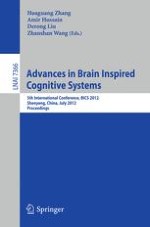2012 | Buch
Advances in Brain Inspired Cognitive Systems
5th International Conference, BICS 2012, Shenyang, China, July 11-14, 2012. Proceedings
herausgegeben von: Huaguang Zhang, Amir Hussain, Derong Liu, Zhanshan Wang
Verlag: Springer Berlin Heidelberg
Buchreihe : Lecture Notes in Computer Science
